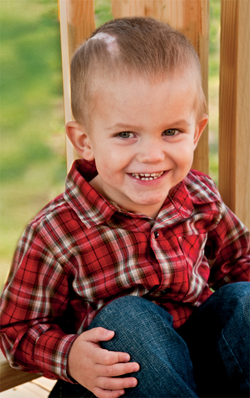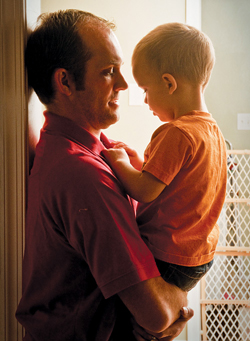 There was no blood, no bump, not even the start of a bruise after 2-year-old Braden fell and smacked his head on a TV stand in his Chesapeake home last fall.
There was no blood, no bump, not even the start of a bruise after 2-year-old Braden fell and smacked his head on a TV stand in his Chesapeake home last fall.
His parents, Brad and Jennifer Hennis, dashed to his side to inspect his injury. Seeing nothing, they cautioned him to be careful and let him return to his toys.
At dinnertime, Jennifer’s mother, Nancy Bennett, arrived to babysit. Learning that Braden’s afternoon nap had been brief, she thought nothing of his dozing on his Elmo couch.
Aware of his earlier fall, however, she worried when she couldn’t wake him all the way up to change him into pajamas. He was extremely groggy, she remembers. So after placing him in his crib, she left his bedroom door open.
Today, his doctors say that open bedroom door helped save Braden’s life.
About a half hour after putting him down, Nancy heard Braden vomiting. “I was really scared,” she says. She called Jennifer and Brad, who rushed home and called 911.
Recognizing that Braden’s condition was critical, Chesapeake EMTs drove straight to Sentara’s Level 1 Trauma Center adjacent to CHKD. There, doctors assessed Braden’s condition and immediately made two calls: the first to CHKD neurosurgeon Joseph Dilustro at home; the second to intensivist Christopher Foley, who was on duty in the Pediatric Intensive Care Unit at CHKD.
On his way in, Dr. Dilustro called CHKD to make sure a pediatric anesthesiologist would be ready; Dr. Justin John adjusted his operating schedule so he could be available.
Every detail fell into place. Just 55 minutes after being rushed from his home in southern Chesapeake, Braden was in surgery at CHKD.
That speed was crucial, says Dr. Dilustro. “When Braden arrived in the operating room,” he explains, “his pupils were fixed and dilated, he had stopped breathing on his own and there was little evidence of any brain function.”
Braden’s parents had no way of knowing that when he struck his head, a skull fracture occurred. The fracture tore an underlying artery on the covering of his brain, creating a massive clot, known medically as an epidural hematoma. The hematoma was rapidly increasing pressure on the brain, whose tissue is like a sponge. The harder the brain is squeezed, the less life-giving oxygen can get to its cells.
“This child was as close to death as a child could be,” Dr. Dilustro adds. “I wasn’t sure he would survive.” Brad and Jennifer knew their son’s condition was grave. “But we didn’t know how bad it was until after Dr. Dilustro removed the clot,” Brad recalls. “The doctors said they weren’t sure he’d live through the night. That pretty much drained the life right out of us.”
 Standing Watch
Standing Watch
After surgery, Braden was admitted to CHKD’s Pediatric Intensive Care Unit under the care of intensivist Christopher Foley. “We were all focused on getting Braden through the next eight to 10 critical hours,” Dr. Foley says. “If he survived, the concern would then be the long-term effects he would have from this brain injury.”
On his first day in the PICU, Braden’s brain and body were cooled to reduce his need for oxygen, a therapy shown to lessen brain damage. But the most important aspect of Braden’s post-surgical care, Dr. Foley explains, “was simply minute-to-minute observation and intervention.”
Sunday morning, just hours after surgery, Braden stunned his doctors, nurses and parents. He opened his eyes. Then he moved his right arm.
“He showed us signs that he was going to be OK as fast as he could,” Dr. Foley says. Through around-the-clock attention, doctors and nurses saw more encouraging glimmers of normal functioning, such as Braden’s eyes opening spontaneously and blinking appropriately when they checked his pupils.
Those signs reassured Dr. Foley enough that he decreased Braden’s sedation and started waking him up earlier than usual after emergency brain surgery. Monday morning, 36 hours after the accident, he took Braden off the ventilator.
On day three, “My son cried and called for his mommy,” Jennifer remembers, tearing up.
Braden’s doctors seemed more shocked than his parents. “I couldn’t believe he was talking on his third post-op day,” Dr. Dilustro says. “For an adult, this would have been an irreversible brain injury.”
Wednesday, only four days after his life-saving surgery, Braden was transferred out of the PICU to a regular patient room.
With Jennifer’s mom caring for their elder son, Tyler, age 9, both parents had been staying at the hospital 24/7. “Friends brought us clothes and food,” Brad recalls. A Chesapeake firefighter for 15 years, he says the outpouring of support from his fellow firefighters was overwhelming. “My lieutenant was there every day.”
 Against the Odds
Against the Odds
One week after his near-fatal fall, Braden stood up. The next day, he tried to walk on his own. Nine days after his brush with death, the 2-year-old was ready for CHKD’s Inpatient Rehabilitation Unit.
“We were all so grateful and amazed by the speed of Braden’s recovery,” says rehabilitation medicine specialist Jean Shelton. “Our job was to help him get his gait and balance back.” Almost unheard of, Dr. Shelton adds, is that Braden needed no outpatient therapies when he was discharged eight days later. “I wouldn’t want him to play contact sports,” she says, guidance she will emphasize during Braden’s occasional follow-up visits through his childhood.
Eighteen days after the biggest fright of their lives, Jennifer and Brad took Braden home – not that he wanted to go. “Everyone in the hospital was so wonderful that he didn’t want to leave them,” Jennifer says, laughing. “They did everything they possibly could to make us comfortable.”
Everyone involved in Braden’s care, says Dr. Foley, could relate to his accident. “It could happen any day to any child,” he says. “My kids are mostly grown, but many of our nurses have young children at home. I know they were thinking, ‘Oh my gosh, this could have been my child.’
“While I would love to take credit for helping Braden recover,” he adds, “he owes it all to prompt and expert surgical intervention. Without it, he would have died.”
Dr. Dilustro practices with CHKD Surgical Group’s Neurosurgery. Dr. Foley practices with Children’s Specialty Group, PLLC, at CHKD. Dr. Shelton practices with the EVMS Department of Physical Medicine and Rehabilitation at CHKD.
This story was featured in the Spring 2012 issue of KidStuff, a publication of Children's Hospital of The King's Daughters. Click to read more patients' stories.